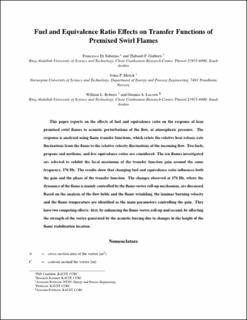| dc.contributor.author | Di Sabatino, Francesco | |
| dc.contributor.author | Guiberti, Thibault | |
| dc.contributor.author | Moeck, Jonas | |
| dc.contributor.author | Roberts, William | |
| dc.contributor.author | Lacoste, Deanna | |
| dc.date.accessioned | 2021-03-01T08:30:52Z | |
| dc.date.available | 2021-03-01T08:30:52Z | |
| dc.date.created | 2020-01-31T15:47:34Z | |
| dc.date.issued | 2020 | |
| dc.identifier.citation | Journal of Propulsion and Power. 2020, 36 (2), 271-284. | en_US |
| dc.identifier.issn | 0748-4658 | |
| dc.identifier.uri | https://hdl.handle.net/11250/2730785 | |
| dc.description.abstract | This paper reports on the effects of fuel and equivalence ratio on the response of lean premixed swirl flames to acoustic perturbations of the flow, at atmospheric pressure. The response is analyzed using flame transfer functions, which relate the relative heat release rate fluctuations from the flame to the relative velocity fluctuations of the incoming flow. Two fuels, propane and methane, and five equivalence ratios are considered. The 10 flames investigated are selected to exhibit the local maximum of the transfer function gain around the same frequency, 176 Hz. The results show that changing fuel and equivalence ratio influences both the gain and the phase of the transfer function. The changes observed at 176 Hz, where the dynamics of the flame is mainly controlled by the flame vortex roll-up mechanism, are discussed. Based on the analysis of the flowfields and the flame wrinkling, the laminar burning velocity and the flame temperature are identified as the main parameters controlling the gain. They have two competing effects: first, by enhancing the flame vortex roll-up and, second, by affecting the strength of the vortex generated by the acoustic forcing due to changes in the height of the flame stabilization location. | en_US |
| dc.language.iso | eng | en_US |
| dc.publisher | American Institute of Aeronautics and Astronautics Inc. | en_US |
| dc.title | Fuel and Equivalence Ratio Effects on Transfer Functions of Premixed Swirl Flames | en_US |
| dc.type | Peer reviewed | en_US |
| dc.type | Journal article | en_US |
| dc.description.version | acceptedVersion | en_US |
| dc.source.pagenumber | 271-284 | en_US |
| dc.source.volume | 36 | en_US |
| dc.source.journal | Journal of Propulsion and Power | en_US |
| dc.source.issue | 2 | en_US |
| dc.identifier.doi | 10.2514/1.B37537 | |
| dc.identifier.cristin | 1788700 | |
| dc.description.localcode | Copyright © 2019 by the American Institute of Aeronautics and Astronautics, Inc. All rights reserved. | en_US |
| cristin.ispublished | true | |
| cristin.fulltext | postprint | |
| cristin.qualitycode | 1 | |
